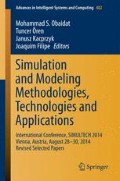Abstract
The behavior of a hybrid system is a mixture of continuous behavior and discrete event behavior. The Simulink/Stateflow toolset is a widely used industrial tool to design and validate hybrid control systems using numerical simulation methods for the continuous parts and an executable Stateflow (combination of Statecharts and Flowcharts) for the discrete event parts. On the other hand, Colored Petri Nets (CPN) is a well-known formalism for modeling behavior of discrete event systems. In this paper, we show how the CPN formalism can be used to model a hybrid system. Then we consider the special case of Simulink/Stateflow models and show how they can be expressed in CPN.
Access this chapter
Tax calculation will be finalised at checkout
Purchases are for personal use only
References
Harel, D.: Statecharts: a visual formalism for complex systems. Sci. Comput. Program. 8, 231–274 (1987)
website, S.: http://nl.mathworks.com/help/simulink/
website, S.: http://nl.mathworks.com/help/stateflow/
Eshuis, R.: Translating safe petri nets to statecharts in a structure-preserving way. In: Cavalcanti, A., Dams, D.R. (eds.) FM 2009. LNCS, vol. 5850, pp. 239–255. Springer, Heidelberg (2009)
Huszerl, G., Majzik, I., Pataricza, A., Kosmidis, K., Dal Cin, M.: Quantitative analysis of UML statechart models of dependable systems. Comput. J. 45, 260–277 (2002)
Merseguer, J., Campos, J., Bernardi, S., Donatelli, S.: A compositional semantics for UML state machines aimed at performance evaluation. In: Proceedings. Sixth International Workshop on Discrete Event Systems, IEEE, pp. 295–302 (2002)
Agrawal, A., Simon, G., Karsai, G.: Semantic translation of simulink/stateflow models to hybrid automata using graph transformations. Electron. Notes Theoret. Comput. Sci. 109, 43–56 (2004)
Tripakis, S., Sofronis, C., Caspi, P., Curic, A.: Translating discrete-time simulink to Lustre. ACM Trans. Embed. Comput. Syst. 4, 779–818 (2005)
Denckla, B., Mosterman, P.J.:. Formalizing causal block diagrams for modeling a class of hybrid dynamic systems. In: IEEE CDC-ECC, pp. 4193–4198 (2005)
Tiwari, A.: Formal semantics and analysis methods for simulink stateflow models. Technical Report, SRI International (2002)
Zhou, C., Kumar, R.: Semantic translation of simulink diagrams to input/output extended finite automata. Disc. Event Dyn. Sys. 22, 223–247 (2012)
Bouissou, O., Chapoutot, A.: An operational semantics for simulink’s simulation engine. In: Proceedings of the 13th ACM SIGPLAN/SIGBED International Conference on Languages, Compilers, Tools and Theory for Embedded Systems. LCTES ’12, ACM, pp. 129–138 (2012)
Hamon, G., Rushby, J.: An operational semantics for stateflow. Int. J. Softw. Tools Technol. Transf. 9, 447–456 (2007)
Hamon, G.: A denotational semantics for stateflow. In: Proceedings of the 5th ACM International Conference on Embedded Software, ACM, pp. 164–172 (2005)
Scaife, N., Sofronis, C., Caspi, P., Tripakis, S., Maraninchi, F.: Defining and translating a safe subset of simulink/stateflow into Lustre. In: Proceedings of the 4th ACM International Conference on Embedded Software, ACM, pp. 259–268 (2004)
Jensen, K., Kristensen, L.M., Wells, L.: Coloured petri nets and CPN tools for modelling and validation of concurrent systems. Int. J. Softw. Tools Technol. Transf. 9, 213–254 (2007)
David, R., Alla, H.: Discrete, Continuous, and Hybrid Petri nets. Springer, Berlin (2010)
Demongodin, I., Koussoulas, N.T.: Differential Petri nets: Representing continuous systems in a discrete-event world. IEEE Transactions on Automatic Control 43, 573–579 (1998)
Gilbert, D., Heiner, M.: From petri nets to differential equations—an integrative approach for biochemical network analysis. In: Donatelli, S., Thiagarajan, P.S. (eds.) ICATPN 2006. LNCS, vol. 4024, pp. 181–200. Springer, Heidelberg (2006)
Reisig, W.: Petri Nets: An Introduction. Springer, New York (1985)
Peterson, J.L.: Petri net theory and the modeling of systems. Prentice Hall PTR, Upper Saddle River (1981)
CPN Website: www.cpntools.org/
Bera, D., van Hee, K., Sidorova, N.: Discrete timed petri nets. Computer Science Report 13–03, Technische Universiteit Eindhoven (2013)
van Hee, K., Sidorova, N.: The right timing: reflections on the modeling and analysis of time. In: Colom, J.-M., Desel, J. (eds.) Petri Nets 2013. LNCS, vol. 7927, pp. 1–20. Springer, Heidelberg (2013)
Bera, D., van Hee, K., Nijmeijer, H.: Relationship between simulink and petri nets. Computer Science Report 14–06, TU Eindhoven (2014)
Bera, D., van Hee, K., Nijmeijer, H.: Relationship between simulink and petri nets. In: Obaidat, M., Kacprzyk, J., Oren, T. (eds.) Proceedings of SIMULTECH 2014: Fourth International Conference on Simulation and Modeling Methodologies. SCITEPRESS, Technologies and Applications (2014)
Author information
Authors and Affiliations
Corresponding author
Editor information
Editors and Affiliations
Rights and permissions
Copyright information
© 2015 Springer International Publishing Switzerland
About this paper
Cite this paper
Bera, D., van Hee, K., Nijmeijer, H. (2015). Modeling Hybrid Systems with Petri Nets. In: Obaidat, M., Ören, T., Kacprzyk, J., Filipe, J. (eds) Simulation and Modeling Methodologies, Technologies and Applications . Advances in Intelligent Systems and Computing, vol 402. Springer, Cham. https://doi.org/10.1007/978-3-319-26470-7_2
Download citation
DOI: https://doi.org/10.1007/978-3-319-26470-7_2
Published:
Publisher Name: Springer, Cham
Print ISBN: 978-3-319-26469-1
Online ISBN: 978-3-319-26470-7
eBook Packages: Computer ScienceComputer Science (R0)

